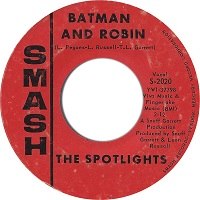
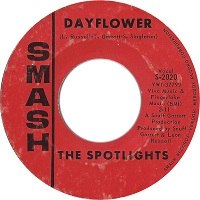
THE SPOTLIGHTS:
Batman And Robin / Dayflower
(45 rpm single)
Original release:
45 rpm single: Smash 2020 (1966)
Other releases:
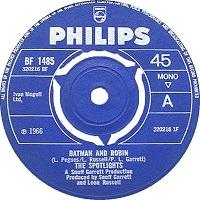
45 rpm single Philips BF 1485 (1966)
| 1. | Batman And Robin | |
| 2. | Dayflower |
Duane Allman is suspected to play on 'Dayflower' (with The Allman Joys), but this has not been confirmed yet.
UPDATE 2019:
On July 30, 2019 David Brown
posted the following in the Brother Duane Allman Facebook group:
facebook.com//BrotherDuaneAllman/1348754311941152/
David Warner Brown: "The Allman Joys had nothing to do with making this
record. They did agree to go out and pretend to be the band on the record to get
some gigs. They were pretty embarrassed about it as I recall."
David Brown has also confirmed to us that this information came directly from
Duane and Gregg Allman.
(In 1968/1969 David Brown was the bass player in 'The 31st Of February', the band
with Butch Trucks on drums and Scott Boyer on guitar and vocals.
The demos they recorded in September 1968 together with Duane and Gregg Allman
at the Tone Studios in Hialeah, FL. were released in April 1972 by Bold Records
as 'Duane And Greg Allman.)
UPDATE 2020:
Michael Ray Fitzgerald:
'Jacksonville And The Roots Of Southern Rock' , page 43 (University Press Of
Florida, Gainesville, FL, 2020):
Also in 1966, Leon Russell and Thomas "Snuff" Garrett wrote and produced
a single, "Batman and Robin," designed to cash in on the superhero craze
fomented by the ABC-TV series. The record was released on Mercury's sister
label, Smash, which was run by producer Shelby Singleton, who would later
work with the Bitter Ind/Tiffany System.
David Brown of the Bitter Ind wrote that the Allman Joys had sheepishly
agreed to pose as the group in order to get some extra work; however, they
did not play on the recording. It was performed by session musicians led by
Russell.
UPDATE 2022:
Bill Thames: 'Paper, Scissors,
Rock-n-Roll' , pages 96-97 (Mercer University Press, Macon, GA, 2022):
. . . This all transpired during the rollout of the Batman television
program. Several record companies intended to capitalize on the growing "superhero"
phenomenon, so the Allman Joys were invited to New York City by Smash Records
and quickly recorded a song titled "Batman and Robin" under the pseudonym the
Spotlights, which Gregg found hard to acknowledge in later years. The song was
recorded as part of an embarrassing project that included a long string of
superhero-themed songs recorded by various musical groups. Very few copies of
this 45 exist today, primarily because so few people ever recognized the
Spotlights as Duane and Gregg's band until recently. One can only surmise that
the record company became concerned about copyright issues with the name the
Allman Joys and the Hershey's "Almond Joy" candy bar, so the name was hastily
changed to protect the recording project. The "B" side of "Batman and Robin" was
the even more forgettable "Dayflower." The Spotlight's 45 recording was
cowritten, engineered, and produced by Leon Russell, Snuff Garrett, and Smash
producer Lou Courtney. A subsequent, even less memorable single, "Dick Tracy,"
with B side "Little Orphan Annie," was released later in 1966. Both Gregg and
Duane Allman would cross paths with Leon Russell later through mutual
association with Delaney & Bonnie & Friends. Gregg and Russell reunited once
again in 2011, joining Elton John in concert at Madison Square Garden. My guess
is that they never talked about the "superhero" project after the records came
out, and that partnership was promptly disavowed and forgotten by all parties
involved.
UPDATE 2023:
Bill Janovitz: 'Leon Russell -
The Master Of Space And Time's Journey Through Rock & Roll History' , page 64 (Hachette
Books, New York, NY, 2023):
. . . In late ’65, Leon and Snuff Garrett produced J. J. Cale’s first record
since arriving in LA the year before. Cale held down the regular gig at the
Whisky, worked day jobs, and helped Leon with the studio. He recorded a track
called “Dick Tracy,” about the comic strip character and released as a single in
October on Liberty. The novelty track is backed with the curiously slinky “It’s
a Go-Go Place” about a groovy sort of establishment down on the Sunset Strip and
sounds like a jingle for the Whisky. And it seems to nod to the girls at the
Classic Cat. Either way, Cale forewarns, over blues changes, “We’re going out to
the edge of your mind / It’s only ten blocks west of mine.” The adolescent boys
at whom “Dick Tracy” was aimed must have found the B-side tantalizing. With the
success of “Dick Tracy,” Snuff and Leon produced a whole album of songs based on
popular comic book characters. The band for the album was billed as the
Spotlights and featured Gregg and Duane Allman, who had previously been known as
the Allman Joys.
[NOTE: The album "The Superrecord Of Superheroes" was not billed as "The Spotlights", but as "The Super Dupers". Only the two single releases on Smash Records (and the single release on Philips) were billed as "The Spotlights".
The release of this single was announced in various music magazines on January 22, 1966:

Billboard, January 22, 1966, page 3

Billboard, January 22, 1966, page 16

Cash Box, January 22, 1966, page 14

Cash Box, January 22, 1966, page 48

Record World, January 22, 1966, page 3
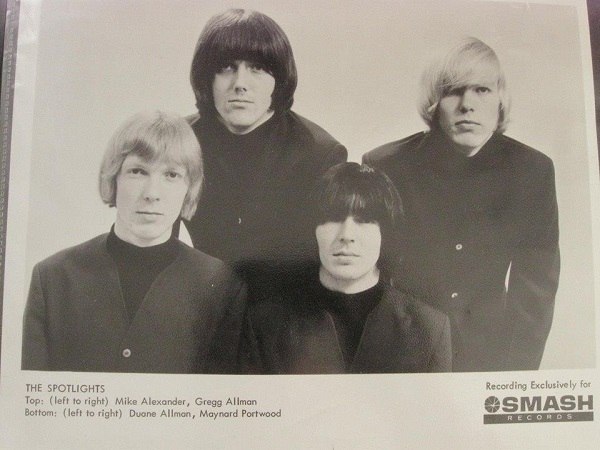
This line-up of "The Spotlights" is the same as the line-up of "The Allman Joys" from 1966, when Mike Alexander had replaced Bob Keller on bass, and before Maynard Portwood was replaced (in New York) by Bill Connell on drums.
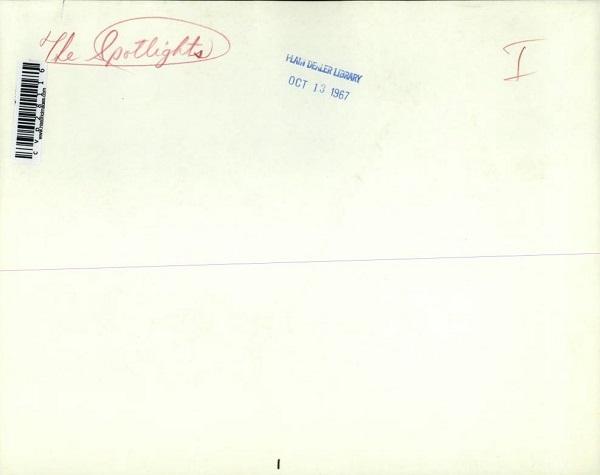
The picture is from the archives of "The Plain Dealer", a newspaper from Cleveland, OH.
(Thanks to Craig Ruskey for these pictures)
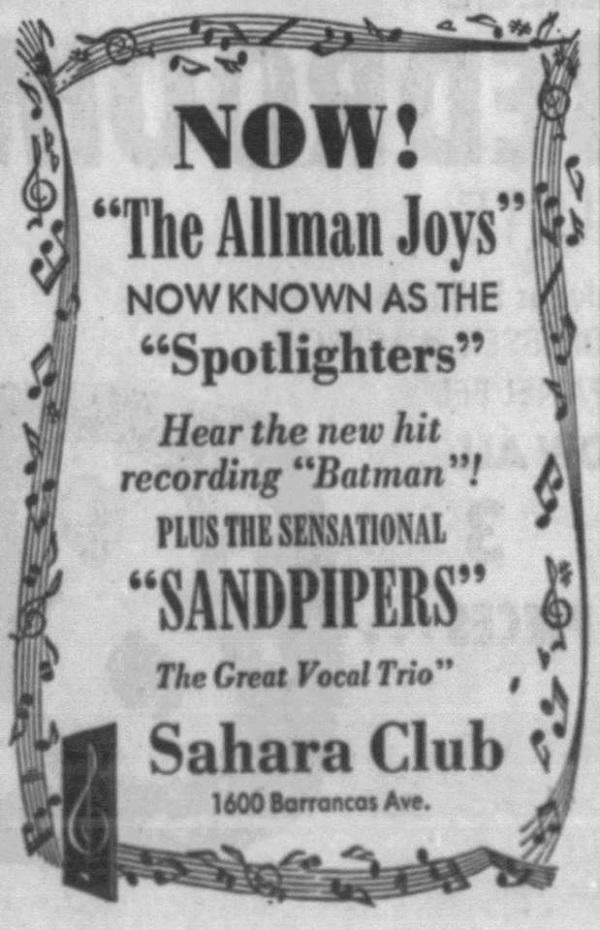
Sahara Club, Pensacola, FL
February 25, 1966
(The Pensacola Journal
February 25, 1966
page 19A)
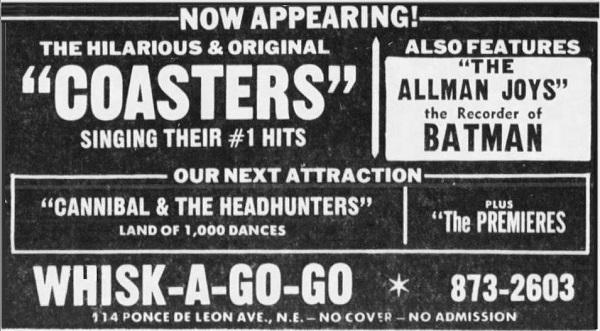
Whisk-A-Go-Go, Atlanta, GA
April 1966
(The Atlanta Consttitution
April 7, 1966
page 36)
On page 38 of his book "Heaven and Hell: My life in The Eagles
(1974-2001)"
(John Wiley & Sons, 2008) Don Felder confirms that "The Allman Joys" also used the name "The Spotlights":

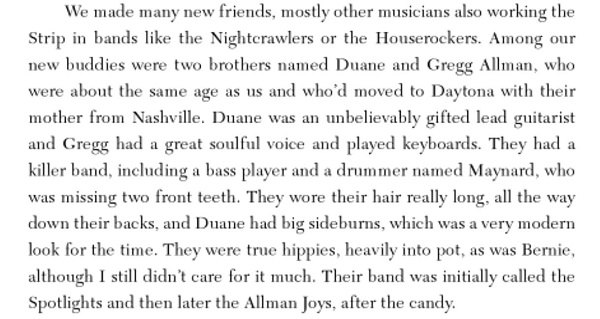
And in these videos Don Felder
also mentioned "The Spotlights":
2 singles by "The Spotlights" were released on Smash Records in 1966:
http://www.globaldogproductions.info/s/smash.html
Smash 2020: Batman And Robin / Dayflower
Smash 2031: Dick Tracy / Little Orphan Annie
The track "Batman And Robin" was originally released on the 1966 LP releases of
"The Superrecord Of Superheroes" by "The Super Dupers" on the "Design"
label (DLP-257 and SDLP-257), the "International Award Series" label (AK-272) and
the "Happy Time Records" label (HT-1042):
|
2 singles by 'The Super Dupers' were released on the 'Cricket' label:
Cricket C-168 (USA): "The Green Hornet / The Blue Mirage"
|
Cricket C-169 / BB-94 (Australia): "March Of Tarzan / The Jungle Jingle"
We have compared the recording of "Batman And Robin" from the Smash single with
the Super Dupers version and it's exactly the same.
The recordings for the LP were made in New York and, just like the 2 "Smash"
singles, produced by Snuff Garrett
and Leon Russell.
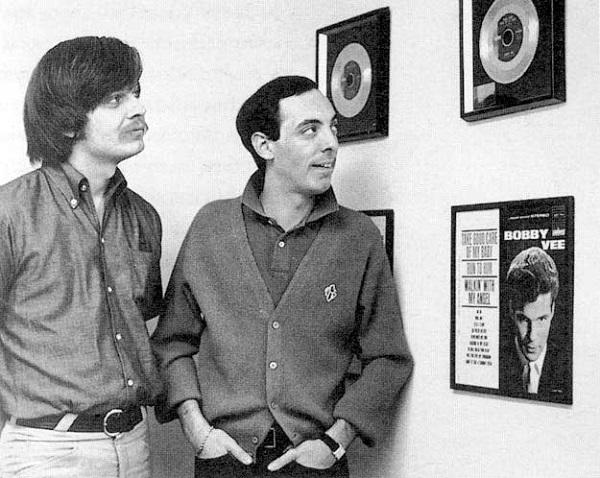
Leon Russel & Snuff Garrett
In this interview J.J. Cale talks about the recording of the Super Dupers LP:
http://thislandpress.com/09/11/2013/the-making-of-longhair-music-2/?read=complete
“Record producer Shelby Singleton was working for Mercury Records at the same
time we did the ‘Dick Tracy’ single [the J.J. Cale version of "Dick Tracy",
released on Liberty Records in 1965], so Leon and Snuff came by one day and
said, ‘You want to go to New York? We’re going to cut a whole album of cartoon
songs.’ That was before LPs were a big deal. So Leon, Snuff , and I went up to
New York City to cut this album. I was sitting in one room writing songs. Leon
was in the studio leading the musicians, and Snuff was coming and getting the
songs from me. He’d come in and say, ‘Write a song about Little Orphan Annie,’
and I’d start writing the song in the room and he’d take it into the studio
where Leon would get all the musicians to play it. It was wild.”
On July 1, 2018 the following
was posted on the 'JJ Cale Deep Dive' Facebook page:
https://www.facebook.com/permalink.php?story_fbid=935413293305125&id=373151412864652
JJ & THE SUPER DUPERS
The late 1950s and first half of the 1960s saw an explosion of renewed
popularity with the super-hero genre in comic book form. DC Comics had
re-invigorated characters like Batman, Flash and the Green Lantern, whilst
Marvel Comics introduced the Fantastic Four. In early 1966, LA record producer
Snuff Garrett concocted an idea to cash in on the comic book craze sweeping the
nation using the talents of his recording crew Leon Russell and JJ Cale. Garrett
also decided to use this venture as a platform to showcase as an up-and-coming
Florida group called Allman Joys, who featured the Daytona Beach brothers Duane
and Gregg Allman.
The whole idea was actually the brainchild of Mercury Records’ producer Shelby
Singleton. With a plethora of super-heroes flitting around not just in comics,
but also on radio and TV, he wanted to make a catchy album of songs to touch
into the early teenage market. In an interview with Steve Todoroff in 1982, JJ
Cale elaborated on the project:
“Record producer Shelby Singleton was working for Mercury Records at the same
time we did the ‘Dick Tracy’ single, so Leon and Snuff came by one day and said,
‘You want to go to New York? We’re going to cut a whole album of cartoon songs.’
That was before LPs were a big deal. So Leon, Snuff, and I went up to New York
City to cut this album. I was sitting in one room writing songs. Leon was in the
studio leading the musicians, and Snuff was coming and getting the songs from
me. He’d come in and say, ‘Write a song about Little Orphan Annie,’ and I’d
start writing the song in the room and he’d take it into the studio where Leon
would get all the musicians to play it. It was wild.”
1966 had been a great year for Snuff Garrett with several top ten hits courtesy
of one of his bands Gary Lewis & The Playboys, which included two of JJ’s
buddies Carl Radle and Jimmy Karstein. Singleton decided to use Garrett’s team
and so off to the Big Apple it was to record an actual album. Up until then, JJ
had worked entirely engineering and playing on singles.
Garrett’s plan was to release a couple of singles under the band’s name, and
then an entire album under a guise. It appears that the venture took place
straight after New Year. The Allman Joys name was considered a bit too offbeat
and so they were redubbed The Spotlights. On 22 January 1966, their first single
was released on Smash Records – “Batman and Robin”/”Dayflower”. Within a month
it charted as high as #12 in their home state. A second single followed in March
with a re-working of JJ’s previously released song “Dick Tracy” with the B-side
being the above-mentioned “Little Orphan Annie” (credited to Cale, Russell and
Garrett).
Meanwhile, the process described by JJ, which had probably occurred over the
period of a week in January, had led to the completion of the super-heroes’
album. Sometime in the early spring, most likely late March, the Spotlights were
re-branded as The Super Dupers and the album was released on the Cricket label,
a front for Pickwick Sales Corporation. It was flippantly called The Superrecord
of Superheroes. The original album had eight tracks spread over almost 26
minutes:
1. Batman & Robin (DC comics 1939)
2. The Phantom (indie comic 1936)
3. The Shadow (1930s radio drama)
4. Flash Gordon (1936 TV series)
5. March of Tarzan
6. Captain Marvel Jones (spin-off of original 1940 Fawcett Comic character)
7. Mickey Mouse March
8. The Green Hornet (indie comic/TV series)
The heroes utilized a broad spectrum of sources. With DC Comics’ Batman
copyright already covered from the single, Garrett chose to mix the rest of the
album with lesser known identities, plus the quirky addition of Tarzan and
Mickey Mouse!
No credits were listed on the album but the Spotlights then consisted of Gregg
Allman (vocals, keyboards), Duane Allman (guitar), Mike Alexander (bass) and
Maynard Portwood (drums). Leon Russell played guitar, co-wrote some songs and
helped produce the LP. The main songwriters were JJ and Lou Courtney. Listening
to the album, JJ’s playing comes out in a number of tracks and it would have
been surprising if he didn’t play at all. The album has a typical light rock
mid-60s feel to it with simple scale driven chords.
Tunes from the album were released as singles under The Super Dupers name, with
tracks not on the actual album included. “The Blue Mirage” was an A-side coupled
with “The Green Hornet” for example, as well as “March of Tarzan” with the
B-side “The Jungle Jingle”. The album appeared with three different covers and
later was re-released with additional tracks including “Little Orphan Annie”, as
Garrett squeezed the lemon to garner additional sales. The latter piece of
information suggests that the LP sold above expectations as further re-packaging
would only have occurred to keep the product’s exposure humming in the market.
The Spotlights eventually morphed into the Allman Brothers Band, famous for
pioneering the style of southern rock. Duane died in a motorcycle accident in
1971. The band continued having their greatest success in 1973 with the #2
single “Ramblin’ Man” taken from the number one album Brothers and Sisters. JJ
Cale connected guitarist Derek Trucks played with the group from 1999 until it
disbanded in 2014. Gregg Allman passed away in May 2017.
The Spotlights/Super Dupers project may seem a bit kitsch to those reflecting on
it today, but like the many singles and artists that Snuff Garrett worked with,
the whole premise was to find a niche or fad and chase the chance of some money.
For JJ, this was a huge new experience in the big smoke of New York. The
pressure to create and meet what was most likely a tight deadline, would have
then been followed up with a lot of partying and probably some visits to venues
the likes of which he’d never seen. The fact that he’d been invited to
participate on the project must have invigorated him. This was different to the
LA scene. JJ probably had a feeling right then, that he was on the path to
something big.
This is the J.J. Cale version of "Dick Tracy", released on Liberty Records 55840 in 1965:
|
On:
http://www.bsnpubs.com/mercury/smash/smash.html
we found the following
information
about a "Spotlights" LP on the Smash Records label that was probably never
released:
|
|
MGS 27081/SRS 67081 |
|
And on: |
Please contact us if you have more information about the involvement of The Spotlights / The Allman Joys in the Super Dupers LP and the Smash singles.
(Thanks to Al Booth for providing info and the recordings of the 2 tracks and to Craig Ruskey for The Spotlights picture and the additional info)